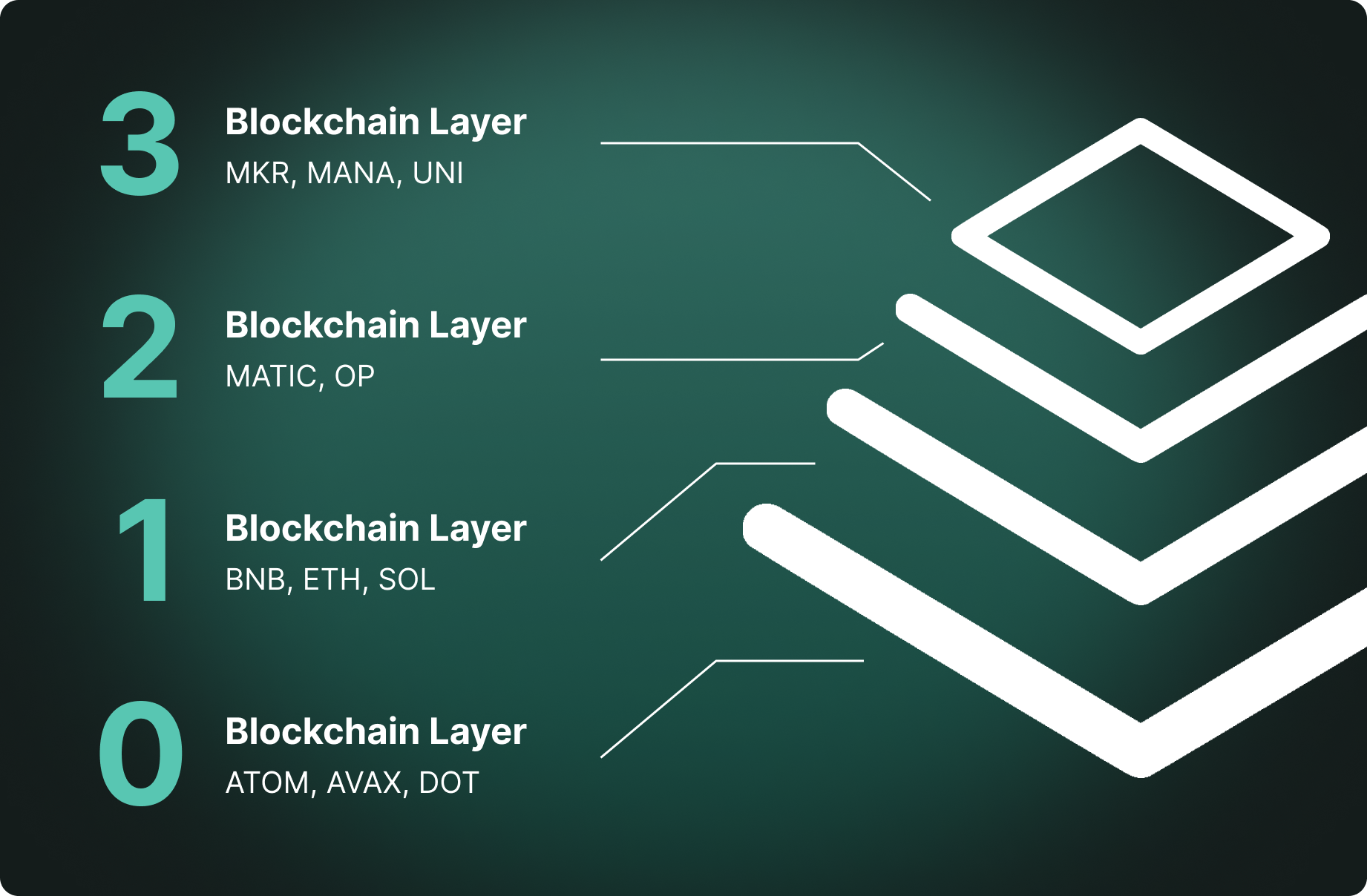Welcome to our course on the various blockchain layers.
The blockchain ecosystem is multi-layered and complex, with each layer offering a variety of functionalities and serving a variety of functions. From the foundational Layer 0 to the user-facing Layer 3 of blockchain technology, all Layers will be covered in this course. Each layer will be thoroughly explored, along with its function, constituent parts, and effect on the overall blockchain ecosystem.
By the end of this course, you will have a better understanding of the different layers in blockchain, and the trade-offs involved in building and using blockchain technology.
So, let’s get started and delve into the world of blockchain, layer by layer!

Layer 0 & Protocol Layer 0
Layer 0 – The Common Foundation
Fundamentally, what is referred to as Layer 0 is the set of components that are common to all blockchains. This layer will include, for example:
- Nodes that confirm and validate transactions
- Servers that serve to run the nodes and the application layer
- Miners in the case of a proof-of-work (PoW) blockchain
- Users who interact with the protocols
- The network with the internet without which, nothing would be possible
All of these components combined allow a blockchain to function correctly in a decentralized manner. If one of the pieces is missing, the foundation would be unstable and risk a structure collapse.
Therefore, all blockchains are built on top of a Layer 0, such as Cosmos, Polkadot, or Avalanche, seeing that they provide hte necessary infrastructure to get started!
The Layer 0 protocols
Layer 0 protocols are actually sets of features that can integrate into Layer 0 with the goal of resolving recurring problems such as:
- Scalability (speed of transactions)
- Interoperability (communication between different blockchains)
- Security
If you want to learn more about this you can read this article written by Vitalik about Sharding where he talk also about «The Scalability Trilemma» or follow our course: Performance vs Decentralization

Rather than trying to create additional layers to solve these fundamental problems, developers choose to work backwards, working on a Layer 0 base allowing the following:
- To create a blockchain more easily with the help of a development kit (SDK)
- Create communication channels between different blockchains that use the same base
- Use the same consensus system or information storage
- Improve security of an infrastructure without necessarily having to manage it
But it must be understood that all of these features will depend on the selected Layer 0 protocol. Some of the most impactful Layer 0s to date include:
- Cosmos (ATOM) which has enabled the creation of many blockchains such as BNB Chain or Terra. To do this, Cosmos offers different solutions: Tendermint Core, Inter Blockchain Communication (IBC) and the Cosmos SDK.
- Polkadot (DOT) which prioritizes security by centralizing it on the parent blockchain (Relay chain). They also have their own development kit (SDK) called Substrate and their communication system Cross-chain Message Passing (XCMP). Their blockchains (parachain) are also developing: Astar, Moonbeam or Acala.
- Avalanche (AVAX) which proposes another cascading design model (heterogeneous model) and the creation of new specialized blockchains (subnets) takes place through the Avalanche Layer 0.
Finally, we see that each of these ecosystems and their blockchains are based on Layer 0 but also have their own Layer 0 protocol, bringing on a new design model that simplifies the creation of new blockchains by using a panel of existing components.
Layer 1
Layer 1 refers to the base network infrastructure of blockchains such as Ethereum, Bitcoin, and more. These networks can validate and finalize transactions without relying on other networks. However, improving the scalability of Layer 1 networks can be challenging, and as a result, developers often create Layer 2 protocols that utilize the security and consensus of the Layer 1 network.
What is a Layer 1?
A Layer 1 is another term for a base blockchain network. Examples of Layer 1 protocols include Ethereum (ETH), Binance Smart Chain (BNB), Bitcoin (BTC), and Solana. These blockchains are referred to as Layer 1 because they are the main networks within their ecosystem, with off-chains and other Layer 2 solutions built on top.
A blockchain is considered a Layer 1 when it can process and finalize transactions on its own blockchain. Additionally, these protocols typically have their own native token used for paying transaction fees.
Layer 1 Scaling:
One of the main challenges of Layer 1 networks is scalability. For instance, Bitcoin and other large blockchains have faced difficulties processing transactions during times of high demand. This is due to the Proof of Work* (PoW) consensus mechanism used by these networks, which requires significant computational resources. While PoW provides decentralization and security, it also slows down when the volume of transactions is too high, leading to longer confirmation times and more expensive fees.
To improve scalability, blockchain developers are exploring various options, including increasing block size, changing the consensus mechanism (Proof of Stake), and implementing sharding. However, implementing improvements to Layer 1 networks can be a complex process that requires a lot of work and may not always be agreed upon by all network participants. This can lead to community division or even a hard fork, as was seen with Bitcoin and Bitcoin Cash in 2017.
Layer 1 network scalability issues are addressed by Proof of Stake (PoS), an alternative consensus mechanism to Proof of Work (PoW). In contrast to PoW, which relies on miners to verify transactions by resolving challenging mathematical puzzles, PoS verifies transactions by randomly choosing a validator to verify a block proportional to the amount of tokens they have staked. As a result, the validator is motivated to act in the network’s best interests because doing otherwise could result in the loss of their staked tokens.
PoS uses a lot less resources and computational power than PoW, making it a more energy-efficient choice. PoS enables Layer 1 networks to process transactions more quickly and effectively, resulting in reduced fees and confirmation times.
PoS is the standard term for this type of consensus, however there are different types. The currencies that users staked in the PoS system would be used as a measure to choose validators. On the other hand, there is Delegated Proof of Stake (DPoS), a method that chooses block producers through a participatory procedure. Delegated Proof of Stake provides greater scaling with fewer block producers.
Another example of a Layer 1 blockchain is KYVE! Built with the Cosmos SDK*, leading a Proof of Stake network.
Layer 2
A Layer 2 refers to a secondary system or protocol that is built on top of an existing blockchain network to address the scalability issues faced by major cryptocurrency networks. The primary aim of these protocols is to increase the transaction speed and handle the scalability challenges that limit the wider adoption of cryptocurrencies.
Bitcoin and Ethereum, for example, are still struggling to process a high number of transactions per second (TPS), which hinders their long-term growth. The adoption of Layer 2 solutions is essential to achieve higher throughput and make these networks more practical for widespread use.
Examples of Layer 2 Solutions
Two of the most significant Layer 2 solutions are the Lightning Network for Bitcoin and the Ethereum Plasma framework used by Polygon, for example. Both of these protocols have different working mechanisms and characteristics, but their primary goal is to provide enhanced scalability to blockchain systems.
The Lightning Network utilizes state channels, which are essentially payment channels attached to the main chain that perform blockchain operations and report them back to the main chain. On the other hand, the Plasma framework consists of sidechains, which are small blockchains structured in a tree-like format.
Off-Chain Scaling Solutions
Layer 2 protocols create a secondary network that operates independently from the main chain (layer 1). These off-chain scaling solutions enable transactions and processes to take place outside of the main chain, resulting in increased scalability. The main chain does not require any significant changes, as Layer 2 is added as an additional layer.
Advantages of a Layer 2
One of the key benefits of Layer 2 solutions is that they provide high throughput without sacrificing network security. The Layer 1 network provides security, while the Layer 2 network offers high scalability and can process hundreds or even thousands of transactions per second. Moving a large portion of the work from the main chain to the second layer allows for better performance and faster processing times.
Layer 3
A Layer 3 refers to the application layer of blockchain technology. It is the layer where various decentralized applications (dApps) are built, including games, wallets, and other blockchain-based solutions. Unlike Layer 1 and Layer 2, which focus on the underlying infrastructure and scalability solutions, Layer 3 focuses on delivering end-user solutions and experiences.
In the context of blockchain, Layer 3 solutions are built on top of Layer 2 protocols, which provide the necessary scalability and security to support these applications. This allows Layer 3 solutions to offer a wider range of experiences and capabilities that are not possible with Layer 1 and Layer 2 alone.
One of the most exciting things about Layer 3 solutions is their potential to disrupt traditional centralized systems. By leveraging the decentralized and trustless nature of blockchain, Layer 3 solutions can offer users new ways to interact with digital assets, perform transactions, and engage in various activities.
For example, blockchain-based games are one of the most popular types of Layer 3 applications. These games allow players to own and trade in-game items, without the risk of a central authority or platform taking control of their assets. Another popular type of Layer 3 solution is cryptocurrency wallets, which allow users to securely store and manage their digital assets.
In conclusion, Layer 3 is a critical component of the blockchain ecosystem. It represents the application layer of blockchain, where various solutions and experiences are being built to take advantage of the capabilities offered by Layer 1 and Layer 2. Whether you’re interested in gaming, finance, or social networking, Layer 3 solutions are at the forefront of innovation in these areas and many others.
A blockchain is made up of at least two layers, and for some of them, much more, as we have seen in this course. In some cases, the addition of all these layers increases the complexity, but this is needed to solve “The Scalability Trilemma,” but let’s not forget that other factors, such as completely decentralized data storage and access, that are not covered in this course are also very important.
You can enroll in the following course to learn more about this issue and how KYVE offers a long-term solution: link to the course.
Conclusion & Resources
Congratulations! You made it through KYVE’s course on the history of blockchain! You are now a pro when it comes to understanding the origins of blockchain technology.
Want to learn more? Feel free to check these resources:
- Visit KYVE Docs to learn more about the KYVE Blockchain.
- Always DYOR before taking action in supporting a Web3 project!
- Run into any terms marked with * that you’re not aware of? Visit the KYVE Glossary to learn what they mean!

